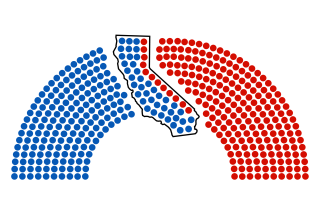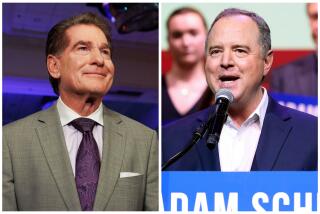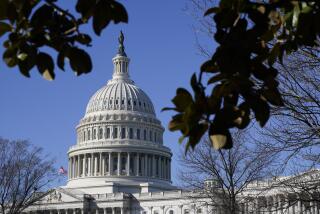It’s a tightening race for governor and Sen. Dianne Feinstein holds strong lead for reelection
Californians overwhelmingly support Sen. Dianne Feinstein’s reelection bid, and she is far better known than her top rival, according to a new USC Dornsife/Los Angeles Times poll. Voters are more divided in the governor’s race, creating a closer contest between Democrats Gavin Newsom and Antonio Villaraigosa.
Newsom leads Villaraigosa by more than 10 percentage points in an election that is shaping up to be competitive, the USC/Times poll found. Newsom, the state’s lieutenant governor, has dominated early polls and fundraising.
“It has all the potential to be a real race,” said Bob Shrum, the director of the Jesse M. Unruh Institute of Politics at USC. “Maybe in California we’re going to have an election that’s not foreordained.” He added that the poll results suggest a repeat of the 2016 Senate contest that featured two Democrats on the fall ballot since no Republicans made it past the top-two primary. The odds of the GOP being shut out in both races are “very high,” Shrum said.
The online poll of 1,296 registered California voters was conducted between Oct. 27 and Nov. 6, one year from the 2018 election. The race for governor has grown increasingly contentious, as the Senate contest gets more crowded. The margin of error was four points in either direction, and higher for subgroups.
Both contests are expected to be among the nation’s marquee races in 2018 as the Democratic Party undergoes a turbulent power struggle between its progressive left and more centrist establishment, especially on issues such as single-payer healthcare. Many millions of dollars will be spent on these premiere political posts in the nation’s most populous and economically powerful state.
Democrats hold a 19-point voter registration edge over Republicans and the GOP has not elected a statewide candidate since 2006. The poll indicates that Democrats’ iron grip on political power in California will not weaken any time soon.
Newsom, who briefly ran for governor in 2009 before dropping out, had the support of 31% of registered voters who plan to cast ballots in the June 5 primary. He was followed by Villaraigosa who had the support of nearly 21%.
Two Republicans — Assemblyman Travis Allen of Huntington Beach and businessman John Cox — are running for governor. Allen stood in third place, winning the support of 15% of voters who plan to cast ballots in the primary. Cox received the support of more than 11% — and the difference between them was within the margin of error. Allen, a Huntington Beach state lawmaker, has little money but is a familiar face to state Republican Party activists. Cox, who is lesser known in state GOP circles, has put $3 million of his own money into his campaign.
According to the poll, 43% of Republican voters favored Allen and 33% backed Cox. A fair share of Republicans — 15% — sided with one of the Democrats. Villaraigosa topped that list, winning the favor of 6% of GOP voters.
The Republicans running for governor, on the other hand, were shunned by Democratic voters: Cox and Allen each had the support of about 1.5% of voters from the other party.
Cox’s standing is roughly tied with state Treasurer John Chiang, a Democrat who has raised several million dollars and is aggressively campaigning across the state. Chiang had 12% support. Former state schools chief Delaine Eastin, also a Democrat, lagged far behind at 4%.
The top picks among independent voters — a growing share of the California electorate — were Newsom and Villaraigosa. Twenty-seven percent backed Newsom and 26% chose Villaraigosa. Among Republican candidates, Allen won 13% of independents compared with 8% for Cox.
Newsom dominated across racial groups and genders, with the sole exception of Latino voters, who favored Villaraigosa, the former Los Angeles mayor, by nearly two to one.
The group is pivotal to Villaraigosa’s campaign. The same goes for voters in Southern California, where Villaraigosa leads in Orange and San Diego counties as well as the Inland Empire.
Voters in Los Angeles County, where Villaraigosa made his name in politics and a linchpin of his path to the governor’s mansion, were split between the two leading candidates. Newsom and Villaraigosa were effectively tied at about 20% each among registered voters. Up north, on Newsom’s home turf, the former San Francisco mayor swamped Villaraigosa, with support from more than 53% of registered voters in the Bay Area compared with Villaraigosa’s 6%.
The field is not settled, with former GOP Rep. Doug Ose considering entering the race.
It’s the most competitive contest in California since 2010, when billionaire Meg Whitman spent more than $178 million — including $144 million of her own money — trying unsuccessfully to stop Jerry Brown from returning to the governor’s mansion. Brown, who also was governor from 1975 to 1983, is finishing his second term of this era and remains the most popular elected official in the state with a 44% job approval rating.
In the U.S. Senate race, Feinstein’s bid for a fifth full term was expected to be a sleepy affair until state Senate leader Kevin de León announced he would attempt to unseat his fellow Democrat.
Feinstein, who has represented California in the Senate for a quarter-century, is known for her measured tone and approach. But she has drawn criticism from liberal voters over her strategy in dealing with Trump, notably her call for “patience” with his presidency earlier this year.
De León — along with potential Senate candidate and billionaire Democratic donor Tom Steyer — have seized upon such remarks as they try to capitalize on Trump’s deep unpopularity among California Democrats.
They face enormous challenges. The USC/Times poll found that in a faceoff between Feinstein and De León, she cruises to victory with the support of more than 58% of registered voters who say they plan to vote, compared to De León’s 31%.
Follow California politics by signing up for our email newsletter »
If Steyer decides to run, he saps support from both candidates — a greater share from De León. In a three-way race, he had 17%, Feinstein won half and De León won the support of nearly a quarter of voters who plan to participate in the primary.
Few voters know who these men are. About 80% of registered voters did not know enough about De León to form an opinion of him, and roughly three-quarters said the same about Steyer. He could attempt to change that by using his personal wealth to saturate the airwaves. That’s an advantage De León does not have.
“De León needs to raise an enormous amount of money if he’s going to get known, to become competitive,” Shrum said.
More than 34% of registered voters viewed Feinstein favorably, compared with 30% who viewed her unfavorably.
Among registered voters who plan to cast ballots, she dominated among genders, races and in every region of the state. Even among GOP voters who plan to vote in the Senate contest, Feinstein won the support of nearly 39%.
Twitter: @philwillon @LATSeema
Yes, Sen. Dianne Feinstein said Trump can be a ‘good president.’ There’s a lot more to the story
Coverage of California politics
UPDATES:
12:25 p.m.: This article was updated with details about how voters view a three-way Senate race with Dianne Feinstein, Kevin De León and Tom Steyer.
This article was originally published at 9:05 a.m.
More to Read
Get the L.A. Times Politics newsletter
Deeply reported insights into legislation, politics and policy from Sacramento, Washington and beyond. In your inbox three times per week.
You may occasionally receive promotional content from the Los Angeles Times.








